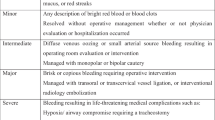Abstract
To review complications including mortality after transoral robotic surgery (TORS) for both benign and malignant pathologies. This is a prospective observational study. Postoperative haemorrhage (8.7%) was the most common complication and 2 (1.7%) mortality were seen in this study. Airway complications and tracheostomy (1.7%), aspiration pneumonia (1.7%), swallowing problems and nasogastric feeding (7%), intra-operative pharyngocutaneous fistula (0.9%) and transient nasal regurgitation (3.5%) were also seen. The more tissue is removed the more is the risk of complication. Complications were mainly seen in the first year of starting the service of TORS and it is a reflection of the learning curve. However, secondary haemorrhage did not follow any pattern in our series. The postoperative haemorrhage was more common in patients with T2 oropharyngeal carcinoma. The mortality was seen in 2 patients (1.7%) with T2 oropharyngeal carcinoma due to postoperative haemorrhage. Higher T stage of oropharyngeal squamous cell carcinoma (OPSCC) needs bigger resection with resultant increase in morbidity.



Similar content being viewed by others

Data Availability
Data collection and analysis were done in accordance with information governance practice of University hospitals of Derby and Burton NHS trust.
References
O’Malley BW Jr, Weinstein GS (2006) Transoral robotic surgery (TORS) for base of tongue neoplasms. Laryngoscope 116(8):1465–1472
Krishnan G, Mintz J, Foreman A, Hodge JC, Krishnan S (2019) The acceptance and adoption of transoral robotic surgery in Australia and New Zealand. J Robot Surg 13(2):301–307
Park YM, Kim WS, De Virgilio A, Lee SY, Seol JH, Kim SH (2012) Transoral robotic surgery for hypopharyngeal squamous cell carcinoma: 3-year oncologic and functional analysis. Oral Oncol 48(6):560–566
O’Hara J, Warner L, Fox H, Hamilton D, Meikle D, Counter P, Robson A, Goranova R, Shahid I, Kelly C, Robinson M, Paleri V (2021) Primary transoral robotic surgery +/- adjuvant therapy for oropharyngeal squamous cell carcinoma—a large observational single-centre series from the United Kingdom. Clin Otolaryngol 46(5):1005–1012
McLeod IK, Melder PC (2005) Da Vinci robot assisted excision of vallecular cyst: a case report. Ear Nose Throat J 84(3):170–172
US Food and Drug Administration (2009) 501(k) Summary: indications for use for intuitive surgical endoscopic instrument control system for transoral otolaryngology procedures. US Food and Drug Administration, Silver Spring, MD
Weinstein GS, O’Malley B Jr, Cohen MA, Quon H (2010) Transoral robotic surgery for advanced oropharyngeal carcinoma. Arch Otolaryngol Head Neck Surg 136(11):1079–1085
Hay A, Migliacci J, KarassawaZanoni D, Boyle JO, Singh B, Wong RJ, Patel SG, Ganly I (2017) Complications following transoral robotic surgery (TORS): a detailed institutional review of complications. Oral Oncol 67:160–166
Chia SH, Gross ND, Richmon JD (2013) Surgeon experience and complications with transoral robotic surgery (TORS). Otolaryngol Head Neck Surg 149(6):885–892
Stokes W, Ramadan J, Lawson G, Ferris FRL, Holsinger FC, Turner MT (2021) Bleeding complications after transoral robotic surgery: a meta-analysis and systematic review. Laryngoscope 131(1):95–105
Mandal R, Duvvuri U, Ferris RL, Kaffenberger TM, Choby GW (2016) Kim S Analysis of post-transoral robotic-assisted surgery hemorrhage: frequency, outcomes, and prevention. Head Neck 38(Suppl 1):E776–E782
Kubik M, Mandal R, Albergotti W, Duvvuri U, Ferris RL, Kim S (2017) Effect of transcervical arterial ligation on the severity of postoperative hemorrhage after transoral robotic surgery. Head Neck 39(8):1510–1515
Pollei TR, Hinni ML, Moore EJ, Hayden RE, Olsen KD (2013) Analysis of postoperative bleeding and risk factors in transoral surgery of the oropharynx. JAMA Otolaryngol Head Neck Surg 139(11):1212–1218
Vergez S, Lallemant B, Ceruse P, Moriniere S, Aubry K, De Mones E, Benlyazid A, Mallet Y (2012) Initial multiinstitutional experience with transoral robotic surgery. Otolaryngol Head Neck Surg 147(3):475–481
Van Abel KM, Quick MH, Graner DE, Lohse CM, Price DL, Price KAR, Ma DJ, Moore EJ (2019) Outcomes following TORS for HPV-positive oropharyngeal carcinoma: PEGs, tracheostomies and beyond. Am J Otolaryngol 40(5):729–734
Williams CE, Kinshuck AJ, Derbyshire SG, Upile N, Tandon S, Roland NJ, Jackson SR, Rodrigues J, Husband DJ, Lancaster J, Jones TM (2014) Transoral laser resection versus lip split mandibulotomy in the management of oropharyngeal squamous cell carcinoma (OPSCC]: a case match study. Eur Arch Otorhinolaryngol 271(2):367–372
Ganti A, Eggerstedt M, Grudzinski K, Ramirez EA, Vaughan D, Revenaugh PC, Stenson K, Al-Khudari S (2020) Enhanced recovery protocol for transoral robotic surgery demonstrates improved analgesia and narcotic use reduction. Am J Otolaryngol. 41(6):102649
Topf MC, Moritz E, Gleysteen J, Curry JM, Cognetti DM, Luginbuhl AJ (2018) First bite syndrome following transcervival arterial ligation after transoral robotic surgery. Laryngoscope 128(7):1589–1593
Author information
Authors and Affiliations
Corresponding author
Ethics declarations
Conflict of interest
There is no conflict of interest and external funding was not needed to support this study.
Additional information
Publisher's Note
Springer Nature remains neutral with regard to jurisdictional claims in published maps and institutional affiliations.
Rights and permissions
About this article
Cite this article
Kumar, S., Mettias, B., Laugharne, D. et al. Morbidity and Mortality Following Transoral Robotic Surgery, a Prospective Single Centre Study. Indian J Otolaryngol Head Neck Surg 74, 422–426 (2022). https://doi.org/10.1007/s12070-021-03033-6
Received:
Accepted:
Published:
Issue Date:
DOI: https://doi.org/10.1007/s12070-021-03033-6


